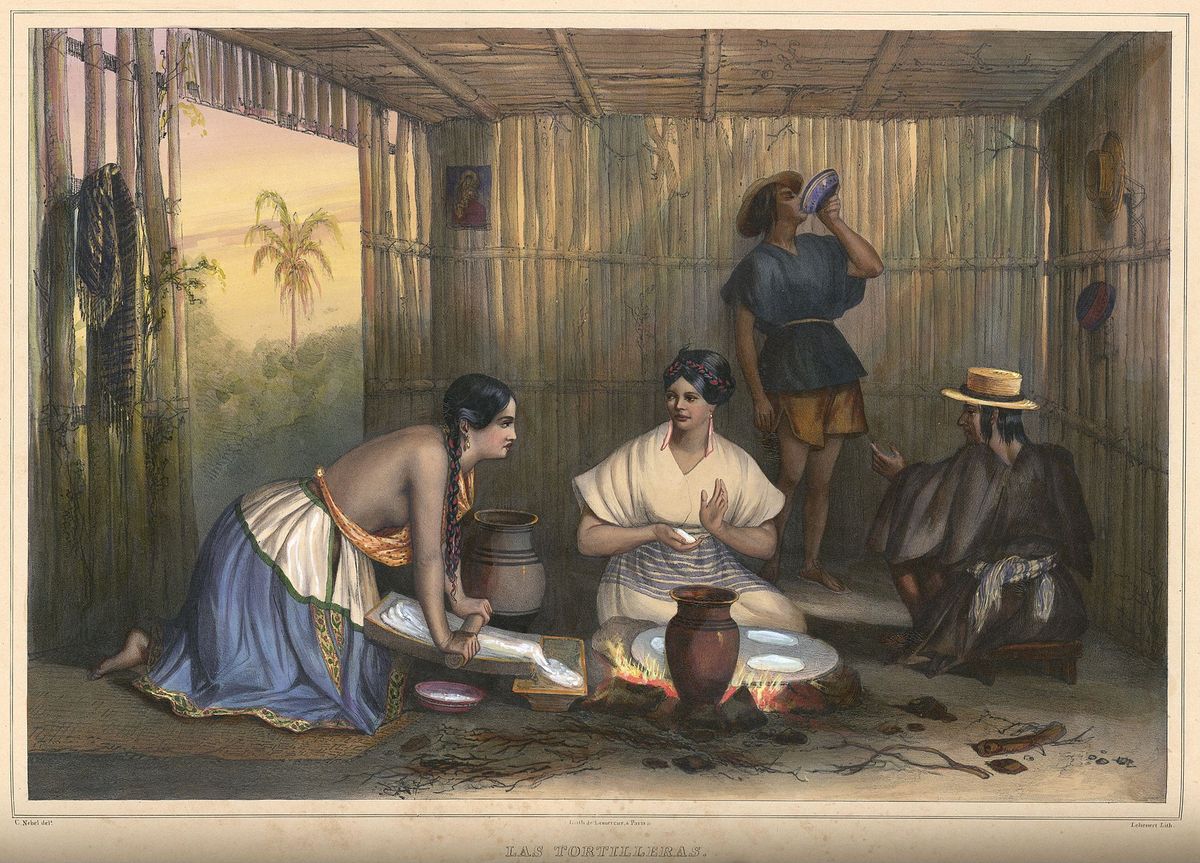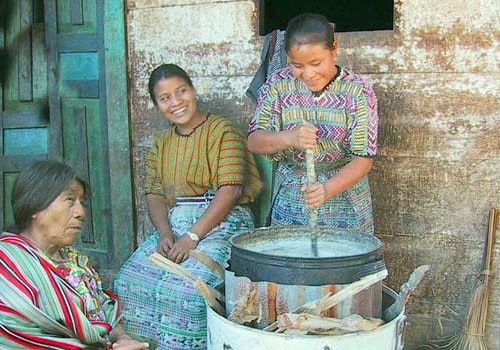Soaking Grains: A Traditional Practice
Humans have been soaking grains for thousands of years. Soaking grains has been practiced by every culture around the world that has subsisted on grains.

Humans have been soaking grains for thousands of years. Soaking grains has been practiced by every culture around the world that has subsisted on grains.
Doesn’t that blow your mind? Every culture. And we wonder why we have so much gluten intolerance today.

Soaking Grains Throughout History
Corn, a staple food in North American and Mesoamerican cultures since pre-Columbian times, has traditionally been soaked in a solution of water and cal, or pickling lime, prior to cooking and eating.
Called nixtamalization, the earliest evidence of soaking corn is found in Guatemala’s southern coast, with equipment dating from 1200-1500 BC.
"Maize subjected to the nixtamalization process has several benefits over unprocessed grain for food preparation: it is more easily ground; its nutritional value is increased; flavor and aroma are improved; and mycotoxins are reduced." (Source: Wikipedia)
Today people have stopped soaking corn, or are soaking it for a much shorter period of time. My former nanny told me that when she grew up in a small village in Guatemala, they always soaked the corn in lime water for 1-2 weeks. Nowadays, she she says they don’t soak it at all — they just cook it with the lime.
Unsoaked Corn and Pellagra
In the early 1900s, for example, in the American South, people were using corn more frequently in their cooking for corn breads, corn grits, and the like. However, unlike our neighbors south of the border who were soaking grains, Americans were not soaking it.
As a result, we saw an epidemic of Pellagra — 100,000 afflicted in 1916.

"The traditional food preparation method of corn, nixtamalization, by native New World cultivators who had domesticated corn required treatment of the grain with lime, an alkali. It has now been shown that the lime treatment makes niacin nutritionally available and reduces the chance of developing pellagra.
"When corn cultivation was adopted worldwide, this preparation method was not accepted because the benefit was not understood. The original cultivators, often heavily dependent on corn, did not suffer from pellagra.
"Pellagra became common only when corn became a staple that was eaten without the traditional treatment."
Soaking Grains: Other Traditional Methods
Corn is not the only grain that has been traditionally soaked and fermented.
"Injera, a pancake-like bread from Africa (specifically Ethiopia and Somalia), is made by mixing teff flour with water and letting it ferment for several days." (Source: Wikipedia).
Similarly, sourdough starter, a mix of fermented flour and water, was used in all bread baking prior to the 20th century. Modern commercial yeast, commonly used in America today, did not exist.
"The sour taste of sourdoughs actually comes not from the yeast, but from a lactobacillus, with which the yeast lives in symbiosis. The lactobacillus feeds on the byproducts of the yeast fermentation, and in turn makes the culture go sour by excreting lactic acid, which protects it from spoiling (since most microbes are unable to survive in an acid environment).
"All yeast-leavened breads used to be sourdoughs, and the leavening process was not understood until the 19th century, when with the advance of microscopes, scientists were able to discover the microbes that make the dough rise." (Source: Wikipedia)
My Experience
I grew up eating sandwiches on white bread and Kraft Macaroni & Cheese. I remember tasting sprouted bread for the first time twenty years ago, when I was in college in San Francisco. On an avocado and cheese sandwich with alfalfa sprouts. I thought it tasted pretty good — and I knew it was healthier, but I didn’t know why.
I’ve bought sprouted bread since that time, as well as German dark rye breads and traditional sourdoughs. I guess I was just always looking for more flavor. I didn’t know these breads were actually healthier.
Reading Sally Fallon-Morell’s book, Nourishing Traditions: The Cookbook that Challenges Politically Correct Nutrition and the Diet Dictocrats,

really opened my eyes. Since I devoured that book two years ago, I’ve been going back to the traditional ways and soaking my grains. I always soak my oatmeal nowadays, and I eat sprouted bread or naturally fermented sourdough bread. I also bake with sprouted flour.
Soaking Grains: Why It’s Important
There are many nutritional benefits to sprouting and soaking grains.
According to Wikipedia:
"Sprouting grains causes increased activities of hydrolytic enzymes, improvements in the contents of total proteins, fat, certain essential amino acids, total sugars, B-group vitamins, and a decrease in dry matter, starch and anti-nutrients. The increased contents of protein, fat, fibre and total ash are only apparent and attributable to the disappearance of starch.
"However, improvements in amino acid composition, B-group vitamins, sugars, protein and starch digestibilities, and decrease in phytates and protease inhibitors are the metabolic effects of the sprouting process."
Soaking Grains Increases Absorption of Minerals
We Americans eat a lot of bread, crackers, tortillas, and oatmeal. All of these things contain phytic acid (and other anti-nutrients). Unless phytic acid is broken down, it actually blocks absorption of important minerals like calcium and zinc.
We all know the nutritional benefits of choosing whole wheat flour over refined white flour. But if we eat whole grains, we’re eating the bran, or the outer part of the grain. That’s where the anti-nutrients like phytic acid are contained. Unless we soak or sprout our whole wheat, and soak our oatmeal and peanuts, we are blocking mineral uptake. Kind of defeats the purpose of trying to eat healthy!
"Phytic acid occurs primarily in the seed coats and germ of plant seeds. It forms insoluble or nearly insoluble compounds with minerals including calcium, iron, magnesium and zinc, such that they cannot be effectively absorbed into the blood. Diets high in phytic acid and poor in these minerals produce mineral deficiency symptoms in experimental animals (Gontzea and Sutzescu, 1958, as cited in Chavan and Kadam, 1989)." Source
Soaking Grains Activates Enzymes
"According to the naturopath and herbalist Isabell Shipard (Shipard, 2005), “Sprouts are a tremendous source of (plant) digestive enzymes. Enzymes act as biological catalysts needed for the complete digestion of protein, carbohydrates & fats. The physiology of vitamins, minerals and trace elements is also dependent on enzyme activity.”" Source
"Grains and legume seeds of all plants contain abundant enzymes. However, while grains and seeds are dry, enzymes are largely inactive, due to enzyme inhibitors, until given moisture to activate germination. It is these inhibitors that enable many seeds to last for years in soil without deteriorating, whilst waiting for moisture.
"Enzyme inhibitors in some grains and legume seeds (for example trypsin inhibitors in raw soybeans and certain other beans and peas) need to be inactivated by heating or other processes, before they can be safely fed. However, heating, cooking and grinding processes can also inactivate certain digestive enzymes within grains and seeds.
"Fortunately, during germination and sprouting of grains and seeds, many enzyme inhibitors are effectively neutralized, whilst at the same time the activity of beneficial plant digestive enzymes is greatly enhanced." Source
Soaking Grains: How to Properly Prepare Grains
There are two ways to reduce phytic acid and increase enzymes. One is to soak or sprout whole grains before using them in recipes. The other way is to soak ground flour in sourdough starter, yogurt, or kefir.
White flour doesn’t have a lot of anti-nutrients, because the anti-nutrients are found in the bran, which has been removed. However, white flour doesn’t have any nutrients either. It’s an empty food that has no real nutritional value.
So, ideally, you want to eat soaked or sprouted whole wheat flour. Try to minimize intake of white flour, but if you do eat it, it’s best to ferment it with sourdough starter, which makes it more digestible.
One trick I employ is to use brown rice pasta instead of regular wheat flour pasta. Brown rice is much more nutritious than refined flour, and rice is not as high in phytic acid so it is not essential that it is soaked. However, I do soak our brown rice when I make it, and we don’t eat a lot of brown rice pasta.
Resources
For information on soaking grains, pick up a copy of Sally Fallon’s Nourishing Traditions: The Cookbook that Challenges Politically Correct Nutrition and the Diet Dictocrats.

Photo credits: Wikipedia



Comments ()